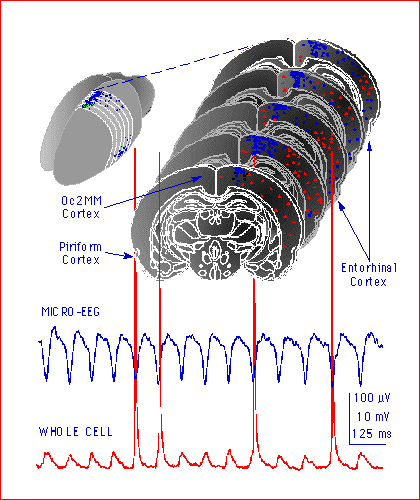
Theta activity can be recorded from specific regions of cortex (blue dots) in rat brain slices. Comparison of micro-EEG signals and intracellular recordings (whole cell) reveal that the low frequency theta waves (~ 8 Hz) were generated by synchronous synaptic potentials and discharge activity of cortical neurons. The discharge of each cortical neuron appears to contribute ~ 1.0 µV to the micro-EEG signal, so theta activity requires synchronous activity in ~ 100 neurons in each recording location. Theta activity is known to be important for spacial mapping and may provide a ‘binding’ mechanism that contributes to the formation of memory in general. When selective populations of neurons are synchronously active they can interact in a Hebbian manner to change the strength of synaptic inputs that are timed at the theta frequency. Theta activity is also known to be particularly sensitive to anesthetic agents at concentrations which block memory formation.
Theta activity requires complex circuit interactions between cortical neurons and appears to be more sensitive to anesthetics than single monosynaptic responses. We expect to find that anesthetics act at multiple pre- and postsynaptic sites to disrupt the synchronous activity of circuits of neurons.
Other brain slice EEG labs: Avoli at McGill, Bland at U Calgary, Buzsaki at Rutgers, Hasselmo at Boston U, Randall at GlaxoSmithKline, Antkowiak at U Tuebingen, McBain at NIH, Reyes at New York U, Whittington at U Newcastle, Konopacki at U Lodz, Sejnowski at the Salk Inst., MacVicar at UBC, Gahwiler at U Zurich, Kauer at Brown U, Alger at U Maryland, Lynch at UC Irvine — let me know if I’ve forgotten anybody please.

